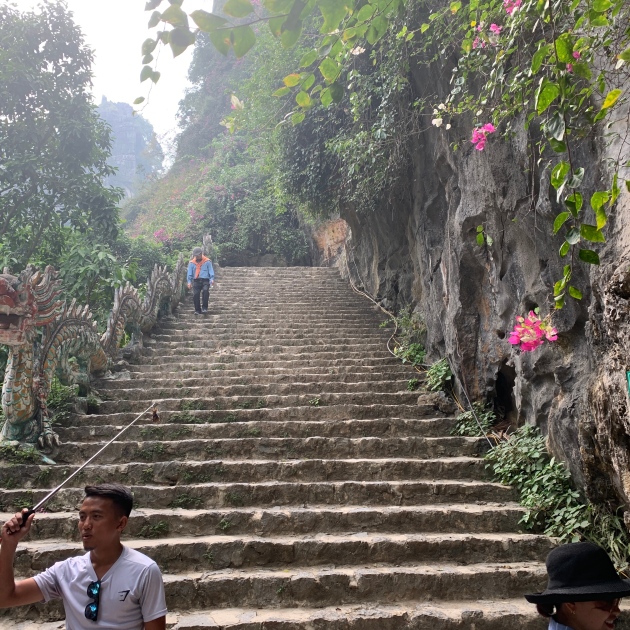Ninh Binh, Vietnam a MUST visit area
Ninh Binh is a hidden gem in Vietnam just S of Hanoi (60 miles). We did not even read much about it in advance of our visit, but I would say DON’T miss this place.
On our river ‘float’ we were rowed by a woman who used her legs to paddle, it was quite a talent. We went into caves and along a stunning river at the base of the limestone structures. We saw a lot of birds on the ride including a variety of king fishers and herons. To be honest the river float could have been shorter. It was 1.5 hours and 1 hour would have been plenty.
Once we arrived back to Hanoi we had an evening walk around the lake and the Friday night market that was certainly geared to locals. It was fun to see the lake come alive and see what the locals do for fun!
“Hanoi Hilton” and other Historical areas of Hanoi
Day 12/12
Started the morning by walking to the St. Joseph Cathedral, (15% of Vietnamese are Catholic). There were many young children on a field trip to the Cathedral. This was the only church we were able to enter during the trip, and so we lit a few candles for those that we’ve lost. 

and then continued onto the “Hanoi Hilton” or the Hỏa Lò Prison. The experience in there was very difficult to process. The French originally built this for Vietnamese political prisoners and first opened the prison in 1880’s. Later it became better known by Americans during the Vietnam War as many American POW’s were kept there including John McCain. Though prisoners reported much torture and interrogation techniques, in the museum today the Vietnam would have you believe that the prisoners loved their time there and enjoyed a happy social life while captivated including time playing cards, chess, shooting pool, and eating a lot of chicken, eggs and food.
Much of the propaganda in the museum currently would have you believe that it was like summer camp for the prisoners. I took photos of how the Vietnam highlighted how other countries helped them during the war and protested the Americans invasion. I showed some of these pics to friends from one of the countries highlighted and she laughed and replied that NONE of those pics were from a protest but rather from a parade for the New Year and one of the other pics didn’t even have the correct language on the store signs. More examples of propaganda on their part.


We then took at tuk tuk (motorcycle with a riding cart behind it) to Truc Bach Lake the lake that John McCain landed in when he was shot down in Hanoi. It is one of the largest lakes in the city. There is a beautiful pagoda on the lake called Tran Quoc and it is the oldest pagoda in Vietnam. It was built in the 6th century. It is built more like an Indian Stupa.
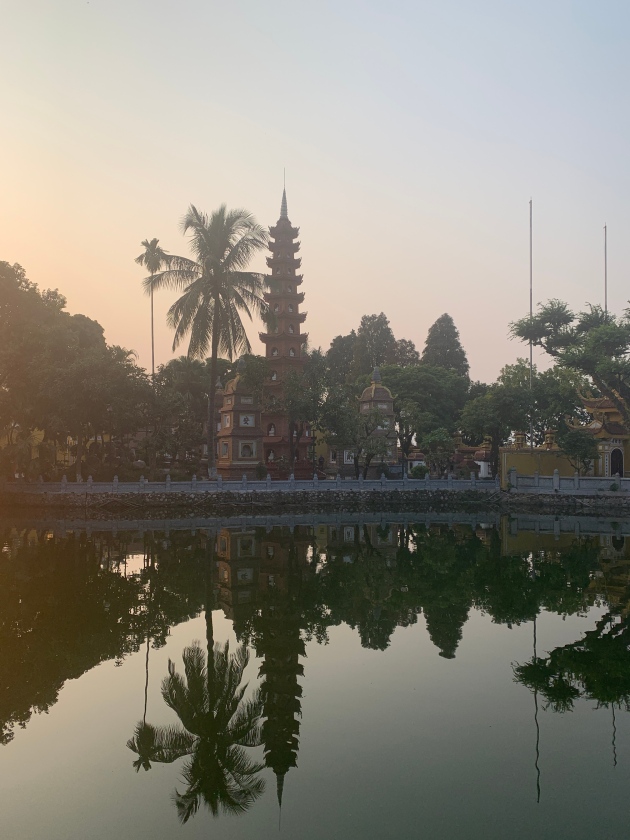

From here we walked to the Ho Chi Minh Mausoleum, which was built in 1975. It reminded me of our Lincoln or Washington Memorials. It is a stand alone structure that is to honor the beloved Ho Chi Minh. There is a paved plaza out front that is long enough for a plane to land on.
Lastly we met our friends for dinner on “chicken street”, where every single stall had chicken and the most desired treat were chicken feet. Harry tried one, but I passed 🙂 My favorite item was the dessert… They took french baguette and smashed them flat then roasted them over an open fire. After they got a little grilled they put honey on it and roasted it some more! Yummy.
On our walk home we saw some street dancers inviting us into their restaurant! 

Hanoi, Vietnam first stop of our trip
The noise and the hustle bustle will be what I remember. The streets are packed with scooters and I mean packed. Everyone drives and rides them.
Day 12/11
We landed at 11 pm and took the advise from the person we rented our apartment from; arrange for a pick up, $20 for the two of us! Was so worth it, Dong our driver was there with a sign and got us straight to our apartment! It was a crazy night in Hanoi as they’d just won a huge Soccer championship and the streets were full on celebration.
We rented an apartment in Old Town and it’s perfect. We are right beside Hoan Kiem Lake and blocks from the Dong Xuan Market.
We started morning by getting cash, $2,000,000 or about $85. Crazy high bills! Then we stopped and got a SIM card. 15 G data and 15 minutes of calling for $14! We’re set.
We started out along Lake Hoan Kiem enjoying the nice park walkway along the edge. From one end we walked a few more blocks to visit the Opera House. Sadly no tours just open for operas in the evenings. Then headed over to Metrepole Hotel which was built in 1909 and survived the bombings during the war.

We continued back to the lake and around to the end where the Rising Sung Bridge takes you to the Ngoc Son Temple on Turtle Island. Entry fee $3 for the two of us.
Onward to the Dong Xuan Market and as warned in the guidebooks it’s basically a market where Vietnamese shop for clothes and accessories. Lots of knock off, nothing too appealing for us.
However outside of the market were lots of food for sale, fruit, corn, beans, vegetables, etc. we bought some apple bananas as we love them.
We then got a brilliant idea to walk across the bridge over Red River. The Long Bien Bridge was the longest in Asia when it was built. It’s a historic bridge for pedestrians and scooters only, no cars. It was longer than we thought; over 1 mile but was a fun walk. It was a great relic of the past. If you look close, you can still see the marks and pillsleft from American bombs.

 We did bring a cab back over the bridge for < $1. Everything is so reasonable.
We did bring a cab back over the bridge for < $1. Everything is so reasonable.
Lastly we had dinner with a former student and walked around the lake in the evening with an almost full moon!

Florence, Italy; All You’ve Ever Dreamed it to Be!
 Jan. 19/20, 2017
Jan. 19/20, 2017
Florence has about 400,000 people and is the ‘richest’ city in Italy. It has no true industry other than tourism, banking and handicrafts. It can not do any more spreading outward because the city has limited where homes and businesses can be built. One interesting story was the one about the Nov. 4, 1966 flood. The Arno bridge overflowed and water ran into the town centers, climbing buildings up to 17′ high. It killed 101 people and damaged or destroyed millions of masterpieces of art and rare books. Much effort has gone into restoration of these works of art, but there are still some that need restored.
We took the fast train to Florence from Venice and it took about 1.5 hours. Once in town we hopped on the bus to our hotel which cost 1.25 E per person. Once settled in we hustled off to town (by foot) so we could visit the Uffizi Museum. The most wonderful thing of traveling ‘off season’ is the fact that there are NO lines! We walked right in! (The cost is 8 E per person).
Before entering the museum we first walked through the courtyards that is lined with sculptures. This U shaped courtyard was purposely built that shape and went from Arno river to the Plaza de Signoria. It was built this way to be theatrical!
Uffizi actually means the ‘offices’ and indeed this is a building that is over 200 years full of different offices. the Top floor was the area for art, but now many floors hold pieces of work. If you follow the suggested path you basically follow the history and evolution of art. It is full of so many pieces of art that you need to just stop and take it all in at different moments of the tour.

We then left and went to the Duomo Cathedral. After some investigations we found out there was a ticket you purchased for 15 E per person that allowed you into 5 places. 1) the basement museum of the Duomo (the least exciting of the sites), 2) the Baptismal 3) the climb to the top of the tower, 4) the climb top of the Duomo and lastly 5)the museum for the Duomo ( a bit down the street). It is good for 48 hours, BUT you can only enter/exit each site ONE time!
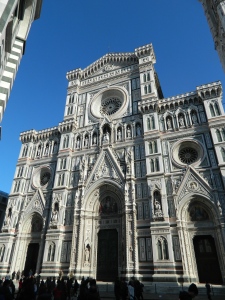 The Duomo is the 3rd largest church in Europe and Duomo means the “home or house of God”. It was started in the 13th Century and finished early in the 1400’s.
The Duomo is the 3rd largest church in Europe and Duomo means the “home or house of God”. It was started in the 13th Century and finished early in the 1400’s.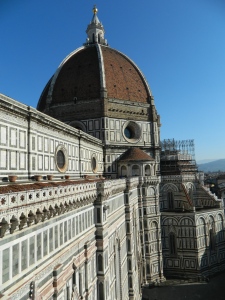
One other tip; YOU MUST pick a time for each of these sites, SO go across from the entry to the Baptismal and look for DOOR #7. There are machines in there that allow you to pick your times. DON’T lose the slips of paper they give you for entry to the sites FOR SPECIFIC TIMES!
Day 2
We cranked it today…9-11 walking tour, 11:30-12:15 hiked to the top of the tower, 12:30-1:30 Academia Museum~ The David, 2:30-3:00 Baptismal, 3:00-4:00 wine and snack, 4:30-6:00 climb to top of Duomo and watched the sunset, 6:30-7:15 dinner, 7:30 Ponte Vecchio Bridge.
The Tower was only 414 steps but the stairs are VERY narrow and when you meet someone coming there in no way to avoid physical contact. Thankfully it wasn’t hot in January! It was beautiful at the top and allowed for great views of the city.
There was NO line at the Academia Museum and so we walked right in! The cost was 12.5 E per person. It is worth every penny to see Michoangelo’s “David”. You hear about it your entire life, you see pictures of it, but the minute you see it in person it takes your breath away. It is stunning. It’s so big and detailed, he veins, those feet, those hands…. wow it is amazing.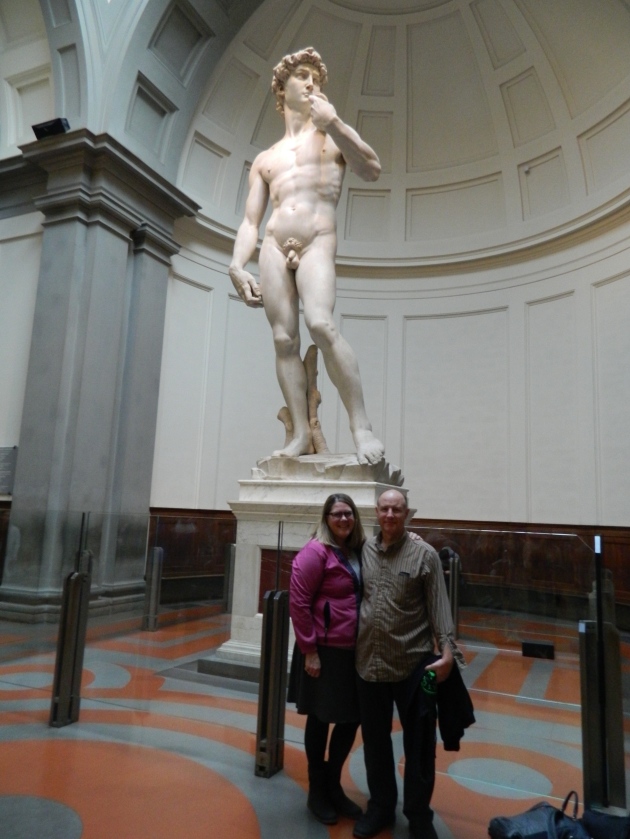
 Stopped through the Baptismal and sat for a while letting the paintings on the ceiling sink in, again it was beautiful. The outer doors of the Baptismal are bronze and well over 1000 years old. Each section tells a story from the Bible.
Stopped through the Baptismal and sat for a while letting the paintings on the ceiling sink in, again it was beautiful. The outer doors of the Baptismal are bronze and well over 1000 years old. Each section tells a story from the Bible.
Upon leaving we went immediately to the Museum of the Duomo. This seems to be a brand new museum and contains the remnants of the original face of the church, before it’s update to the renascence era. It’s worth going through!
We selected 4:3o as a great time to climb to the top of the Duomo as we wanted to be at the top for sunset. This was a climb of 463 steps, some very steep, but again WELL worth the climb. The sunset was beautiful and the views of the city were stunning.
Our last stop of Florence was to walk the Ponte Vechio bridge, the ONLY bridge that the Natzi’s did NOT destroy during WWII. In the days of long ago this bridge was lined with butchers, but over the years the butchers were kicked out and it has become full of jewelry stores and other gift stores.
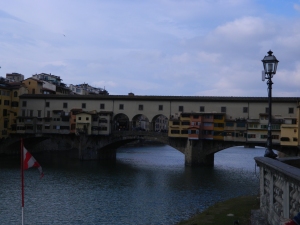
Florence is amazing and it is fun just to walk the streets and stop in to have a pizza and glass of wine OR some gelato!
A stop through Venice, Italy
Jan. 17/18, 2017
On our whirl wind trip to Venice, Florence and Rome we began in Venice. Staying in Venice proper can be a bit costly not to mention a challenge in finding the place you booked because there are not clear ‘roads’ in Venice! Hence we stayed in Mestre, right across the harbor from Venice and opted to take the train into Venice which ran 1.25 E / per person / per way!
Venice is made up of 118 small islands, most separated by canals. Some of these canals are only 5 feet deep! These islands are connected by 404 different bridges. There are NO motorized vehicles in Venice so boats are the mode of transportation. There are boat taxi’s, (7.5 E per ride or 20 E for unlimited all day), gondola rides (80 E for ride up to 6 ppl for that cost) and a lot of people walking!
There are only 50,000 people currently living in Venice and about 2000 leave per year because of the very high cost of living. Most workers live in Mestre and commute over. Mestre has 350,000 people living there!
Our day included a boat ride to Murano Island to view traditional glass blowing, using traditional methods. While touring the store we were shocked that some items were over 100,000 Euro! Beautiful but costly! Originally the glass was colored by a variety of items; green= copper/ blue= cobalt and red=gold hence red was the most costly.
 Once back to Venice we toured around learning about the many campos that are the big squares around the city. Historically these were the gardens or fields of the area. Virtually everyone has a church, a well, and a palace. There are more than 150 churches in Venice and most are Roman Catholic.
Once back to Venice we toured around learning about the many campos that are the big squares around the city. Historically these were the gardens or fields of the area. Virtually everyone has a church, a well, and a palace. There are more than 150 churches in Venice and most are Roman Catholic.
 Ultimately we made it to St. Marco Square, the largest in Venice. It was named after St. Marco the patron saint of Venice. Most simply call it ‘the plaza’ of Venice. We toured St. Marks, (St Mark’s Basilica) the largest church in Venice. All of the gold on the outside is indeed 24 K leaf paint. It took over 700 years to decorate this church. The columns came from Turkey.
Ultimately we made it to St. Marco Square, the largest in Venice. It was named after St. Marco the patron saint of Venice. Most simply call it ‘the plaza’ of Venice. We toured St. Marks, (St Mark’s Basilica) the largest church in Venice. All of the gold on the outside is indeed 24 K leaf paint. It took over 700 years to decorate this church. The columns came from Turkey.
 The Horses of Saint Mark is a set of Roman bronze statues of four horses were first placed on the porch of St. Marks’s in 1204. However, Napoleon took them in 1797, and were ultimately returned in 1815. The horses stayed place on the porch of St. Mark’s until the early 1980s. At that point due to air pollution, and weather issues the originals were moved inside to the museum and the ones on the porch now are exact replicas. To view the inside of the church is free, but it is worth it to spend the 5 E to go upstairs and see the original horses and to see the view from the porch.
The Horses of Saint Mark is a set of Roman bronze statues of four horses were first placed on the porch of St. Marks’s in 1204. However, Napoleon took them in 1797, and were ultimately returned in 1815. The horses stayed place on the porch of St. Mark’s until the early 1980s. At that point due to air pollution, and weather issues the originals were moved inside to the museum and the ones on the porch now are exact replicas. To view the inside of the church is free, but it is worth it to spend the 5 E to go upstairs and see the original horses and to see the view from the porch.
After St. Mark’s we found the Church of Frari which did cost 3 E to go through but again was worth the money. We used the Rick Steve’s app to listen to his tour of this church.
Lastly we walked over to the Rialto Bridge which spans the Grand Canal and it is the oldest bridge in Venice. There were bridges in this location as early as 1181 but this version was built in 1591.


All in all our day was full and we enjoyed the experiences in Venice. Wish we had 1 more day but onward to Florence.
Chevak, Alaska; pull out a map!
March 22-25, 2016
When doing superintendent searches I get to go to a lot of great places, and this adventure lead me to Chevak. I flew from Juneau to Anchorage and Anchorage to Bethel on an Alaska Air jet then took a smaller airline (Grant Air) to Chevak. Chevak is located on the north bank of the Niglikfak River, 17 miles east of Hooper Bay in the Yukon-Kuskokwim Delta. Chevak is a Cup’ik Alaska Native village. The original tribe is the Qissunamiut Tribe. Commercial fishing and subsistence activities are an important part of the local culture. The community is not on the road system. The landscape consists of flat tundra and there are no trees, hence when it snows there are a lot of drifts and whipping wind! However, the river and rolling hills create a beautiful village and there are mountains with trees in the distance.
Alaska Native Cup’ik’s have inhabited the region for thousands of years. Chevak is also known as New Chevak because residents inhabited another village called Chevak before 1950. “Old” Chevak, on the north bank of the Kiuqllivik River, 9 miles east of Hooper Bay, was abandoned because of flooding from high storm tides. The name Chevak refers to “a connecting slough,” on which “Old” Chevak was situated. Chevak is one of two remaining Cup’ik communities.
Fish, seal, beluga, walrus, clams, waterfowl, editable plants and berries are harvested in this maritime climate. Temperatures range from -20º (with windchill) to 79ºF, while we were there it was 23 with windchill down in the single digits. Snowfall averages 20 inches per year. Freeze-up occurs at the end of October; breakup occurs in May or June.
I have to say the Cup’ik people are very friendly and proud of their local traditions and culture, and Chevak is said to be the friendlies village in Alaska. There are a lot of snowmobiles/snow machines AND 4 runners in town, but very few full sized vehicles. It is a dry village and the sale, importation or distribution of alcohol is banned in the village.

Enter a caption

taking advantage of the strong winds that blow through Chevak.

School District Logo



Enter a caption

kids are so happy and loving!

The Pledge of Allegiance in Cup’ik

When you enter the school there are cabinets full of traditional art! Aren’t these beautiful?
Dutch Harbor / Unalaska the port was as busy, ever in February!
Feb. 19/20 (21)
When you land and get off the plane in Unalaska you are happy to stretch your legs and be on solid ground. It took over 3 hours to get here with a stop along the way in Cold Bay for fuel. The planes are smaller and the bathroom on them give a new meaning to ‘feeling like a sardine in a tin can”.
My friend was there greet me and the first person I met with long time Mayor Shirley Marquardt. That’s how the day continued. Meeting a lot of folks and exploring the beauty of the island.
This is the #1 fishing port in the United States for seafood landings and the docks are almost non stop with over 700 million pounds of fish and crab go through there per year. Because of all this fish/crab work there are eagles EVERYWHERE and they are the biggest eagles I have ever seen.
The community here is so diverse, options for meals out offer great options and king crab is on every menu! I don’t know if you can ever get sick of those big rich bites of king crab!
I ended up spending an extra day/night because the pilot of my plane called in sick and there was no room on any other flight. It wasn’t the worst place I have ever been stuck! That allowed me to explore a bit more.
I enjoyed the visit and hope to be invited back again!

the Cathedral of the Holy Ascension of Christ; the oldest cruciform style Orthodox church in N. America!
Unalakleet, Alaska with no snow in January
Jan 20-21, 2016
As I flew into Unalakleet my heart sank and I was so saddened to see that there was almost NO ice in the Bering Sea and there was no snow on the ground. Over the last 7 years that I have been coming here in Jan. this is the least snow or ice I’d ever seen. I realized that I wished those that think ‘climate change’ isn’t real could come here to see this.
I could only imagine what the locals must be experiencing and someone directed me to this article. http://www.adn.com/article/20141116/facing-climate-change-unalakleet-will-endure. It really talks about how the locals are affected by the climate change that is occurring in the region.
My training went wonderfully, I sang an Aleut song with the group. We had a great time learning, dancing, singing and sharing stories. I got to visit my friends there and spend time with their children, and you all know how I love being ‘auntie timi’ for an evening. I love that 3 of the people who came for training brought their small children because we are there for ALL the children of Bering St. School District. AND I LOVE that I got to see a former student of mine, Donald. He picked me up at the airport and we got to have lunch together. He is from here and though he went away for college, he’s back home. These are the reasons I love to visit here and why I can’t wait to return.
Nome, Alaska’s and a visit to NACTEC
Jan. 13-15, 2016
January in Nome is a lot different than June J https://timistravels.wordpress.com/2015/08/07/council-alaska-and-the-last-train-to-nowhere/ but one thing that is similar is that it is bright and sunny regardless of how long the sun is in the sky. When I was in Nome in June the sunrise was at 4:40 a.m. and the sunset was at 1:20 a.m. for 20 hours of sunlight. In January the sun rose at 11:40 a.m. and set at 4:40 p.m. for 5 hours of sunlight. The sunrises were absolutely beautiful as were the sunsets!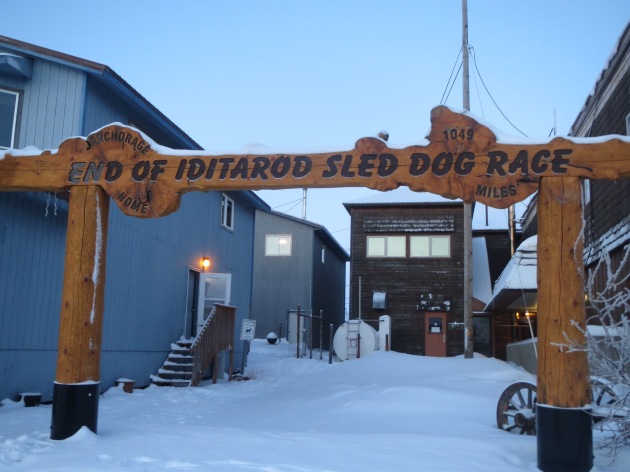






I like to take a few pictures of grocery store items just to give readers an idea how much items are in the places I visit. Remember Nome is a ‘hub’ community so their prices are lower than the villages outside of here.
While in Nome this time I was privileged to tour the Northwest Alaska Career and Technical Center or NACTEC as it is known in the region. NACTEC is a joint venture between Bering Strait School District and Nome Public Schools. The focus of the center is vocational and life skill training for students of both districts. A major focus of the school is not only technical skills, but employability skills.
Students attend for 1, 2 or 4 week sessions. Students must apply to attend and travel to Nome for these programs. The students live on campus while they are in town and in there lies the life skills; meal prep, cleaning of common areas and rooms, laundry, time management and living with others. Many of these youth have not been out of their remote villages ever and most will be away from family for the first time.
Classes taught include:
- Introduction to the Health Field
- Emergency Trauma Technician
- Health aid pre classes
- Profession in the workplace
- Native Arts and Business and Marketing
- Business Entrepreneurship
- Small Business Grant Writing
- Facility Maintenance Introduction
- Heavy equipment
- Renewable energy
- Welding
- Arctic survival
- Outdoor leadership/Guiding
- Culinary Arts
Studies are indicating an increase in graduation rates that coincide with with the start of NACTEC being offered to village students. It is a wonderful program.



